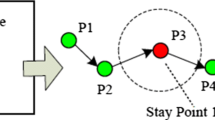Abstract
The mobile wireless market has been attracting many customers. Technically, the paradigm of anytime-anywhere connectivity raises previously unthinkable challenges, including the management of million of mobile customers, their profiles, the profiles-based selective information dissemination, and server-side computing infrastructure design issues to support such a large pool of users automatically and intelligently. In this paper, we propose a data mining technique for discovering frequent behavioral patterns from a collection of trajectories gathered by Global Positioning System. Although the search space for spatiotemporal knowledge is extremely challenging, imposing spatial and temporal constraints on spatiotemporal sequences makes the computation feasible. Specifically, the mined patterns are incorporated with synthetic constraints, namely spatiotemporal sequence length restriction, minimum and maximum timing gap between events, time window of occurrence of the whole pattern, inclusion or exclusion event constraints, and frequent movement patterns predictive of one ore more classes. The algorithm for mining all frequent constrained patterns is named cAllMOP. Moreover, to control the density of pattern regions a clustering algorithm is exploited. The proposed method is efficient and scalable. Its efficiency is better than that of the previous algorithms AllMOP and GSP with respect to the compactness of discovered knowledge, execution time, and memory requirement.


















Similar content being viewed by others
Explore related subjects
Discover the latest articles, news and stories from top researchers in related subjects.References
Agrawal R, Srikant R (1994) Fast algorithms for mining association rules. In: Proceedings of VLDB, pp 487–499
Agrawal R, Srikant R (1995) Mining sequential patterns. In: Proceedings of ICDE95, pp 3–14
Allen JF (1983) Maintaining knowledge about temporal intervals. Commun ACM 26:832–843
Brakatsoulas S, Pfoser D, Tryfona N (2004) Modeling, storing and mining moving objects databases. International database engineering and applications, symposium, pp 68–77
Hadjieleftheriou M, Kollios G, Gunopulos D, Tsotras VJ (2003) On-line discovery of dense areas in spatio-temporal databases. In: Proceeding of international conference on spatiotemporal, database, SSTD03, pp 306–324
Han J, Pei J, Yin Y (2000) Mining frequent patterns without candidate generation. In: Proceeding of ACM SIGMOD
Jensen S, Kligys A, Pedersen TB, Timko I (2004) Multidimensional data modeling for location-based services, VLDB, pp 1–21
Nanopoulos KA, Karakaya M, Yavas G, Ulusoy O, Manolopoulos Y (2003) Clustering mobile trajectories for resource allocation in mobile environments. In: Proceedings of intelligent data analysis conference, vol 2810, pp 319–329
Mamoulis N, Cao H, Kollios G, Hadjieleftheriou M, Tao Y, Cheung DW (2004) Mining, indexing, querying historical spatiotemporal data. In: Proceeding of the 10th ACM international conference on SIGKDD, pp 236–245
Pfoser, Jensen CS (1999) Capturing the uncertainty of moving-object representations. In: Proceedings of advances in spatial databases, 6th international symposium SSD, pp 111–132
Srikant R, Agrawal R (1996) Mining sequential patterns: generalizations and performance improvements. In: Proceeding of EDBT’00, pp 3–17
Tsoukatos, Gunopulos D (2001) Efficient mining of spatiotemporal patterns. In: Proceedings on SSTD, LNCS, pp 425–442
Wang Y, Lim EP, Hwang SY (2003) On mining group patterns of mobile users. In: Proceedings of DEXA, pp 287–296
Yava G, Katsaros D, Ulusoy O, Manolopoulus Y (2005) A data mining approach for location prediction in mobile environments. Data Knowl Eng Arch 54
Zaki MJ (2000) Sequence mining in categorical domains: incorporating constraints. In: Proceedings of CIKM, pp 422–429
Ester M, Kriegel HP, Sander J, Xu X (1996) A density-based algorithm for discovering clusters in large spatial databases with noise. In: Proceedings of ACM knowledge discovery and data mining, pp 226–231
Meratnia N, By RD (2002) Aggregation and comparison of trajectories. In: Proceeding of GIS02, ACM
Vu THN, Lee Jun Wook, Ryu Keun Ho (2008) Spatiotemporal pattern mining technique for location-based service system. In: Proceedings of information, telecommunications and electronics. ETRI J 30(3):421–431
Hipp J, Guntzer U, Nakhaeizadeh G (2000) Algorithms for association rule mining—a general survey and comparison, ACM SIGMOD
Vu THN, Ryu KH, Park N (2009) A method for predicting location of mobile user for location-based services system. Comput Ind Eng J 57(1):91–105
Han J, Kamber M (2006) Data mining: concepts and techniques, 2nd edn. Morgan Kaufmann Publishers, Massachusetts
Acknowledgments
This work was supported by the Research Grant from Vietnam’s National Foundation for Science and Technology Development (NAFOSTED), No. 102.02-2011.13.
Author information
Authors and Affiliations
Corresponding author
Rights and permissions
About this article
Cite this article
Vu, T.H.N., Lee, Y.K. & Bui, T.D. A technique for extracting behavioral sequence patterns from GPS recorded data. Computing 96, 163–188 (2014). https://doi.org/10.1007/s00607-013-0333-1
Received:
Accepted:
Published:
Issue Date:
DOI: https://doi.org/10.1007/s00607-013-0333-1




